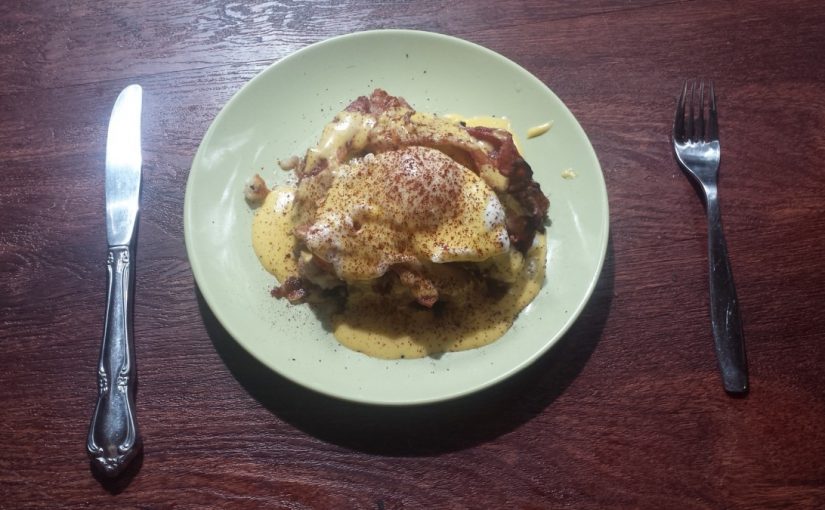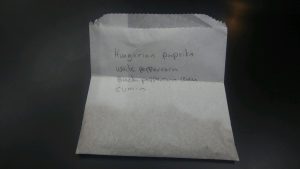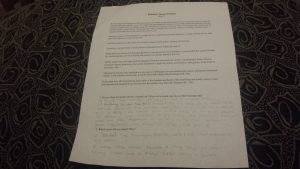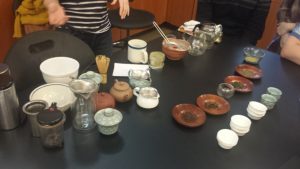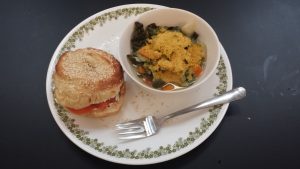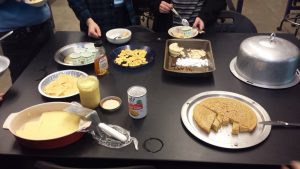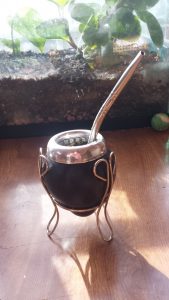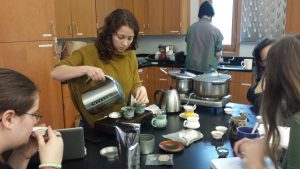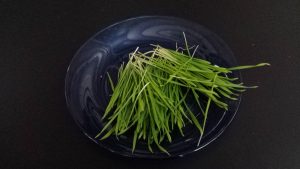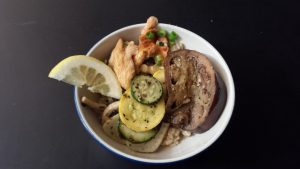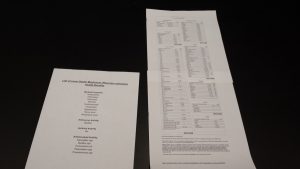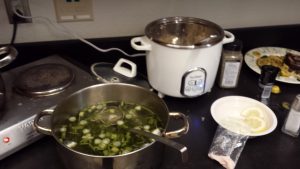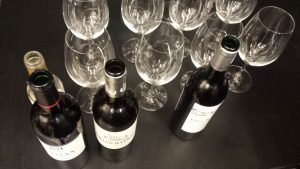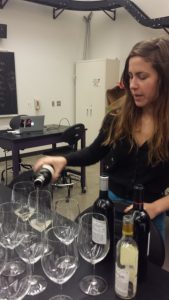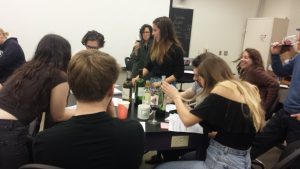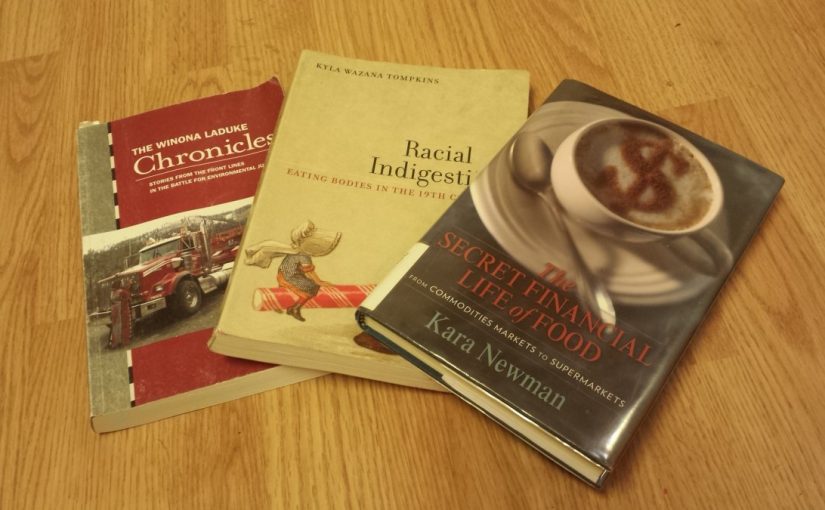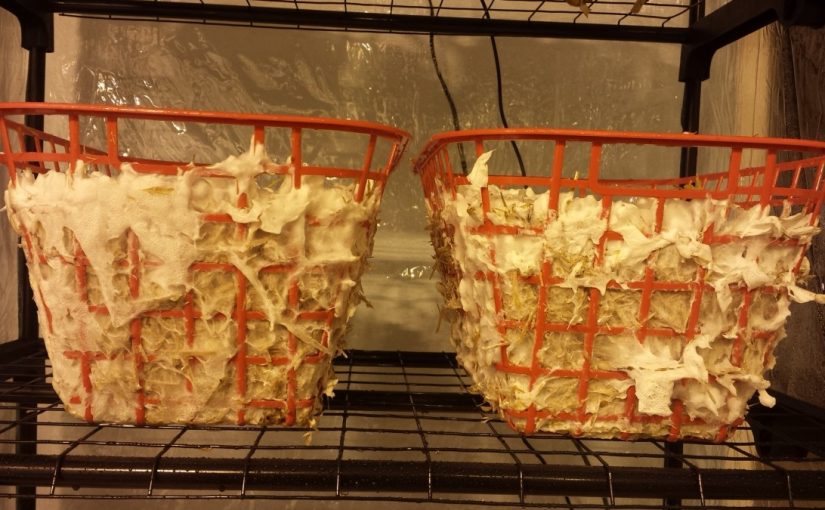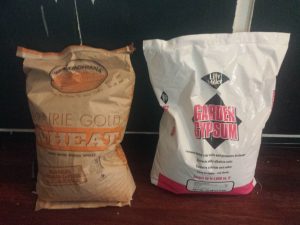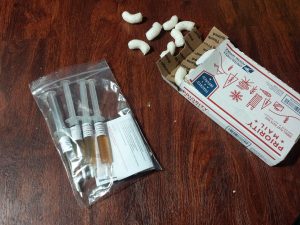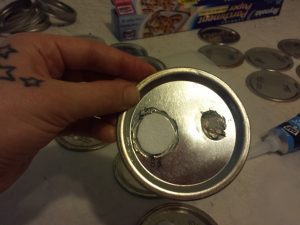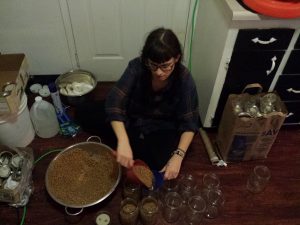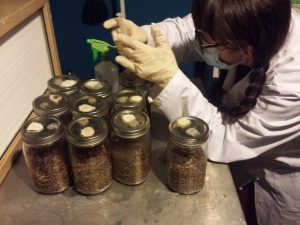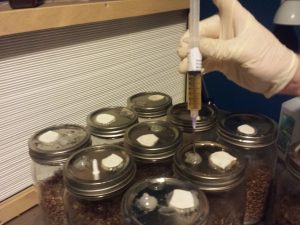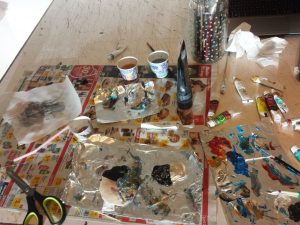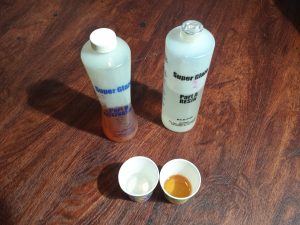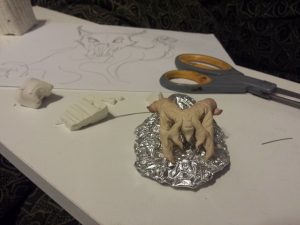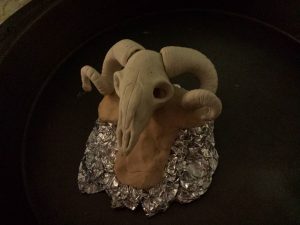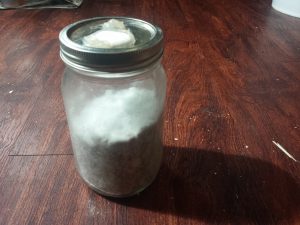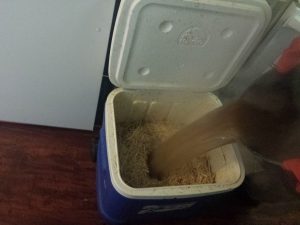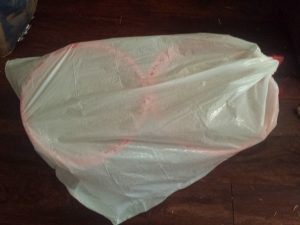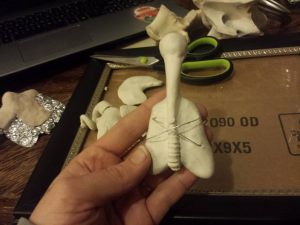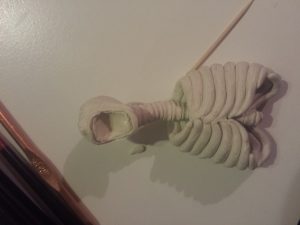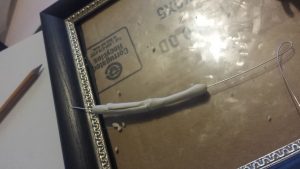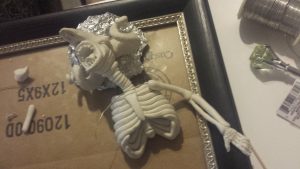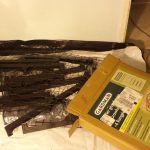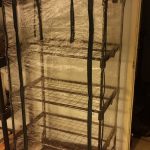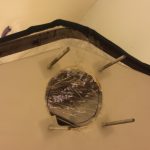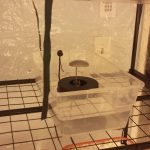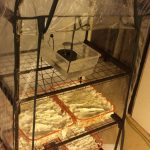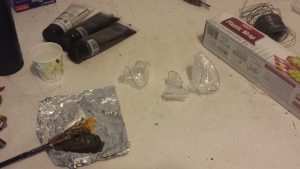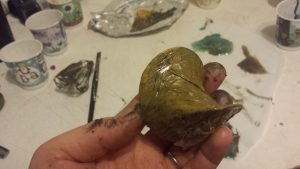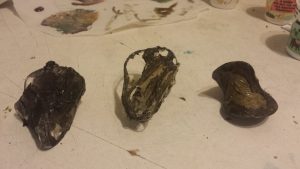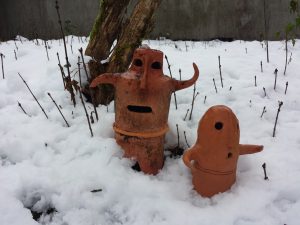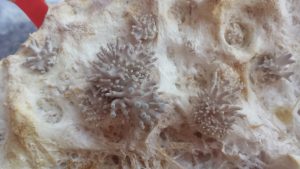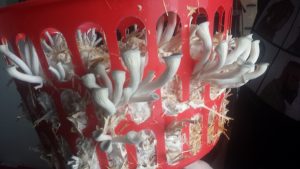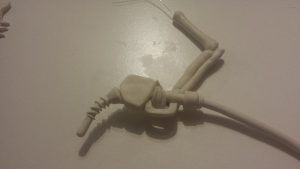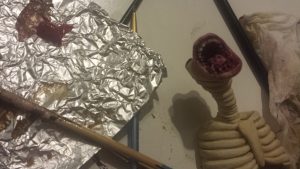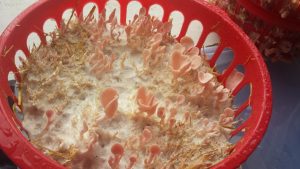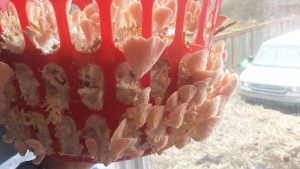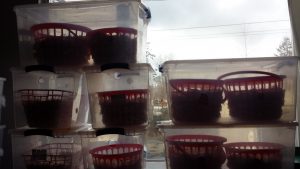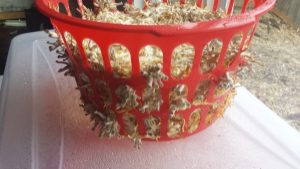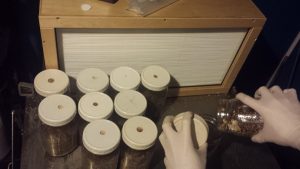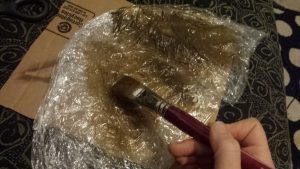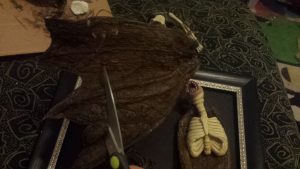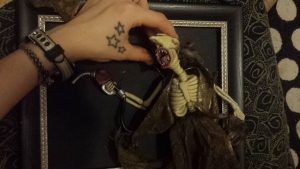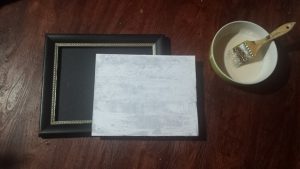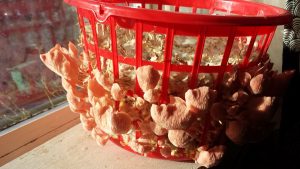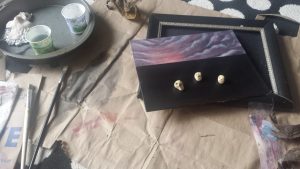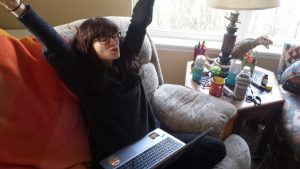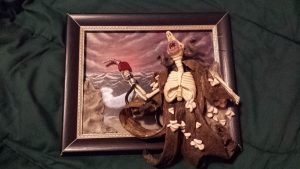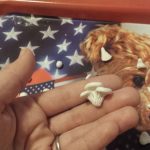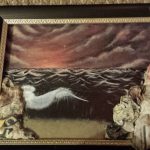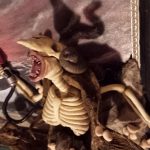Kirstin “Frankie” Humason
SOS: ComAlt, Seminar Pre-Writing Week 2
14 Jan 2017
Word Count : 244
Triggering passages:
The kitchen, in turn, is increasingly the space into which disorder, garbage, contagion, dirt, noise, and other abject sensory experiences are projected. Those projections, all associated with ideological work of disgust and therefore constituted by disgust’s other, desire, stick to the kitchen’s residents, the hyperembodied subjects-disruptive, forbidden, marginally social, and therefore deliciously attractive-who come to be associated with its labor and products (Tompkins 2012:17).
The impact of commodities trading changes over time. It is also important to understand how commodities trading has evolved. Hart estimates that for every dollar spent on food, 15 to 20 cents represents the raw commodities used in that product. The rest represents advertising, transportation and fuel, labor, real estate, and other inputs. He also points to a 2008 study by the USDA, which figured out how much went into creating a box of cornflakes. “They figured out you paid more for the packaging surrounding those Rakes than you did for the corn in the corn flakes!” he crows. “What this tells you is that while food prices can move dramatically, in the scheme of things, they are not a big part of what goes into the price of those corn flakes.” (Newman 2013:14)
News articles:
‘BioClay’ a ground-breaking discovery for world food security
A University of Queensland team has made a discovery that could help conquer the greatest threat to global food security – pests and diseases in plants. http://phys.org/news/2017-01-bioclay-ground-breaking-discovery-world-food.html
Junk food cravings are triggered by the mere thought of being low class
Link between socioeconomic and poor nutrition may partly be in the mind. http://arstechnica.com/science/2016/12/junk-food-cravings-are-triggered-by-the-mere-thought-of-being-low-class/
Discussion:
The first chapter of Racial Indigestion goes into origins of how people associated themselves with the kitchen space. The passage describes how people and laborers of the kitchen became perceived negatively over time. As Tompkins writes “The kitchen, in turn, is increasingly the space into which disorder, garbage, contagion, dirt, noise, and other abject sensory experiences are projected.” Being associated with the kitchen meant being associated with those negative projections. Either way, the passage shows a disconnect between how the kitchen is perceived and what is actually going on. The kitchen, or hearth, was once a very positive place of sitting, eating, storytelling, etc.
I chose the second triggering passage from The Secret Financial Life of Food, Newman explains how most of what the consumer pays for goes into the packaging and not the actual product. When buying a box of cornflakes, the actual cornflakes are the cheapest part of the product. Many studies have shown that people are attracted to lots of packagings. Products of the same, and sometimes better quality, go unsold because the packaging are seen as sub-par. I think aspects of the way we market food further disassociates people from understanding what they are consuming. For example, one of the news article I included was a study of people eating poorly because they perceive themselves as lower class.
Both these passages show an element of illogical association between the consumer and their food. In the first passage these associations begin in the kitchen and spread to everything associated. In the second passage, the association is in the product before entering the kitchen.
Citations:
‘BioClay’ a ground-breaking discovery for world food security. (2017, January 11) received from http://phys.org/news/2017-01-bioclay-ground-breaking-discovery-world-food.html
Beth M. (2016, December 24) Junk food cravings are triggered by the mere thought of being low class. Receved from http://arstechnica.com/science/2016/12/junk-food-cravings-are-triggered-by-the-mere-thought-of-being-low-class/
Newman, Kara. (2013). The Secret Financial Life of Food: From Commodities Markets to Supermarkets. New York: Columbia University Press.
Tompkins, Kyla Wazana. (2012). Racial Indigestion: Eating Bodies in the 19th Century. New York: New York University Press.
Kirstin “Frankie” Humason
SOS: ComAlt, Seminar Pre-Writing Week 3
24 Jan 2017
Word Count : 243
Triggering passage:
Three Wishes has an explicitly class-based cautionary message derived from magical happenings that take place around the hearth. The story tells of a poor man, “Homespun,” and his wife, susan, who are “honest folks in humble life / who liv’d contented with their lot / And lov’d the comforts of their cot.” One night they are sitting at the hearth talking (“And o’er the fire the parents sat / Engaged in sober, social chat”) when a fairy-whom Homespun had previously saved from being hunted when she was disguised as a hare-appears to grant them three wishes. (Tompkins 2012:26)
Although European explorers, particularly the dutch and Portuguese, would continue to search for new spice trade, by the nineteenth century, spices were no longer viewed as exotic. “Pepper-pot” stews were considered mundane affairs for the middle and lower classes and not to be eaten by courtiers. (Newman 2013:21)
News articles:
How Cash Bail Keeps the Poor in Jail
Inability to pay bail is often the only reason a pretrial defendant stays behind bars. https://www.theatlantic.com/politics/archive/2017/01/cash-bail-criminal-justice-reform/513083/
Pope calls on Trump to help the poor
Pope Francis congratulated US President Donald Trump on his inauguration yesterday, urging the new president to keep fighting for the poor at a time of “grave humanitarian crises”. https://stluciatimes.com/2017/01/21/pope-calls-trump-help-poor
Discussion:
What struck me the most in chapter one of Racial Indigestion would be the fairy tale: The three wishes. I think this section of the chapter interested me because it struck a personal chord from my childhood. What I found frustrating was how difficult it was for the couple to get out of the confinement of their class. I think it shows the lack of education the class was subject to, which directly impacted the couple’s ability to overcome their situation, despite being given a golden ticket into a higher class.
I chose the news article “How cash bail keeps the poor in jail” and “Pope calls on Trump to help the poor”, because they reminded me of the three wishes fairy tale. Growing up I always assumed that cops and laws were in place to keep people safe. As an adult I came to realize the boundaries of safety only stretch to certain classes of people. It wasn’t until I was in my early twenties when I was a dirty homeless traveling musician, where I first came in contact with how police target people of low class. As a white middle class child, I had an incorrect view, thinking poor people choose to not better their own lives, but now as an adult I see how unfair systems are in place to keep the poor poor.
In chapter two of The Secret Financial Life of Food, I noticed a similar concept of keeping higher classes separated from the middle and lower class by not eating spices considered common.
Citations:
Tompkins, Kyla Wazana. (2012). Racial Indigestion: Eating Bodies in the 19th Century. NewYork: New York University Press.
Newman, Kara. (2013). The Secret Financial Life of Food: From Commodities Markets to Supermarkets. New York: Columbia University Press.
Anne Kim. (2017) How Cash Bail Keeps the Poor in Jail. Receved from: https://www.theatlantic.com/politics/archive/2017/01/cash-bail-criminal-justice-reform/513083/
St. Lucia Times. (2017) Pope calls on Trump to help the poor. Receved from: https://stluciatimes.com/2017/01/21/pope-calls-trump-help-poor
Kirstin “Frankie” Humason
SOS: ComAlt, Seminar Pre-Writing Week 4
29 Jan 2017
Word Count : 231
Triggering passage:
Like so many other staple foods in early America, corn had a dual identity as food and commodity. Indeed, this dual identity made corn indispensable to the slave trade: corn was both the currency traders used to pay for slaves in Africa and the food upon which slaves subsisted during their passage to America. (Newman 2013:28)
Bread has generally been considered as the staff of life to man, being the most important and universal article of his sustenance. For this reason, it is the practice of all wise states to subject the price and quality of this grand staple of our food, to the regulation of the civil magistrate….Of such importance is the article of bread, that the government of every country ought to hold a controlling hand of those circumstances, within its reach, which may have a tendency to augment the price of this commodity. (Tompkins 2012:58)
News articles:
Does Bread Make You Fat? Nutrition Facts You Need to Know
High carbs and bread nutrition are often promoted in schools and doctors offices; however, this dietary approach has mostly been a failure, with two-thirds of the American population being overweight or obese.
http://www.foods4betterhealth.com/does-bread-make-you-fat-nutrition-facts-you-need-to-know-28286
Price of corn sets pace for local economy in South Dakota
The price of corn has been a steady indicator of the state and metro areas’ economies in recent decades. When corn prices go up, the local economy outperforms the national economy. When corn prices go down, the local economy lags behind the national economy. http://rapidcityjournal.com/news/latest/price-of-corn-sets-pace-for-local-economy-in-south/article_6c2c8bed-68a5-5113-974f-ea1ff5cd6c79.html
Discussion:
I find it interesting how throughout history bread was considered to be so valuable that it was used to control people. Bread, being the main staple used for feeding society, was regulated heavily by the government. It was in the government’s favor to have control over its quality and price.
I find it quite disturbing how a commodity like bread held so much power that it could control people.Today the meaning behind bread has shifted, not only does bread no longer hold the same importance, more and more people are considering it to be bad or unhealthy, causing illness and obesity.
Corn played a similar role, being used as currency to buy slaves as well as being a major food staple, but unlike bread, the importance of corn is still rising. Health benefits and non food related uses are being discovered.
Unlike our not so distant past, American people have more choice on how they feed themselves. Supermarkets contain a high variety of foods. People do not need to rely on just one food as a staple, but this doesn’t mean food no longer holds great power. In places such a South Dakota, corn has a big influence on the the economy. I think it’s important that people pay attention to the powers behind food commodities because of its potential to affect us as individuals as well as a nation.
Citations:
Newman, Kara. (2013). The Secret Financial Life of Food: From Commodities Markets to Supermarkets. New York: Columbia University Press.
Tompkins, Kyla Wazana. (2012). Racial Indigestion: Eating Bodies in the 19th Century. NewYork: New York University Press.
Jon, Yaneff. (2017). Does Bread Make You Fat? Nutrition Facts You Need to Know. Received from: http://www.foods4betterhealth.com/does-bread-make-you-fat-nutrition-facts-you-need-to-know-28286
Argus, Leader. (2017). Price of corn sets pace for local economy in South Dakota. Received from: http://rapidcityjournal.com/news/latest/price-of-corn-sets-pace-for-local-economy-in-south/article_6c2c8bed-68a5-5113-974f-ea1ff5cd6c79.html
Kirstin “Frankie” Humason
SOS: ComAlt, Seminar Pre-Writing Week 5
2 February, 2017
Word Count : 244
Triggering passage:
Like so many other staple foods in early America, corn had a dual identity as food and commodity. Indeed, this dual identity made corn indispensable to the slave trade: corn was both the currency traders used to pay for slaves in Africa and the food upon which slaves subsisted during their passage to America. (Newman 2013:28)
Bread has generally been considered as the staff of life to man, being the most important and universal article of his sustenance. For this reason, it is the practice of all wise states to subject the price and quality of this grand staple of our food, to the regulation of the civil magistrate….Of such importance is the article of bread, that the government of every country ought to hold a controlling hand of those circumstances, within its reach, which may have a tendency to augment the price of this commodity. (Tompkins 2012:58)
News articles:
Does Bread Make You Fat? Nutrition Facts You Need to Know
High carbs and bread nutrition are often promoted in schools and doctors offices; however, this dietary approach has mostly been a failure, with two-thirds of the American population being overweight or obese. http://www.foods4betterhealth.com/does-bread-make-you-fat-nutrition-facts-you-need-to-know-28286
Price of corn sets pace for local economy in South Dakota
The price of corn has been a steady indicator of the state and metro areas’ economies in recent decades. When corn prices go up, the local economy outperforms the national economy. When corn prices go down, the local economy lags behind the national economy. http://rapidcityjournal.com/news/latest/price-of-corn-sets-pace-for-local-economy-in-south/article_6c2c8bed-68a5-5113-974f-ea1ff5cd6c79.html
Discussion:
I find it interesting how throughout history bread was considered to be so valuable that it was used to control people. Bread, being the main staple used for feeding society, was regulated heavily by the government. It was in the government’s favor to have control over its quality and price.
I find it quite disturbing how a commodity like bread held so much power that it could control people.Today the meaning behind bread has shifted, not only does bread no longer hold the same importance, more and more people are considering it to be bad or unhealthy, causing illness and obesity.
Corn played a similar role, being used as currency to buy slaves as well as being a major food staple, but unlike bread, the importance of corn is still rising. Health benefits and non food related uses are being discovered.
Unlike our not so distant past, American people have more choice on how they feed themselves. Supermarkets contain a high variety of foods. People do not need to rely on just one food as a staple, but this doesn’t mean food no longer holds great power. In places such a South Dakota, corn has a big influence on the the economy. I think it’s important that people pay attention to the powers behind food commodities because of its potential to affect us as individuals as well as a nation.
Citations:
Newman, Kara. (2013). The Secret Financial Life of Food: From Commodities Markets to Supermarkets. New York: Columbia University Press.
Tompkins, Kyla Wazana. (2012). Racial Indigestion: Eating Bodies in the 19th Century. NewYork: New York University Press.
Jon, Yaneff. (2017). Does Bread Make You Fat? Nutrition Facts You Need to Know. Received from: http://www.foods4betterhealth.com/does-bread-make-you-fat-nutrition-facts-you-need-to-know-28286
http://www.foods4betterhealth.com/does-bread-make-you-fat-nutrition-facts-you-need-to-know-28286
Argus, Leader. (2017). Price of corn sets pace for local economy in South Dakota. Received from: http://rapidcityjournal.com/news/latest/price-of-corn-sets-pace-for-local-economy-in-south/article_6c2c8bed-68a5-5113-974f-ea1ff5cd6c79.html
Kirstin “Frankie” Humason
SOS: ComAlt, Seminar Pre-Writing Week 6
10th February 2017
Word Count : 249
Triggering passage:
To the Native community, the debate remains a clear example of a discriminatory legal system. Indeed, since the Supreme Court’s 1978 decision in Oliphant vs Suquamish Indian Tribe stripped tribal communities of much jurisdiction over non-tribal members, many reservations are now the residence to large non-Native populations. (LaDuke 2016:131)
Also, the beef Trust was a notable target in Upton Sinclair’s book The jungle, in which he wrote about deplorable conditions in packingtown” and rampant corruption in the meatpacking industry: “It seems that they must have agencies all over the country, to hunt out old and crippled and diseased cattle to be canned. (Newman 2013:99)
News article:
Citizens Bank Target of Boycott and Divestment Protest
PROVIDENCE — The call has been sounded across the country to halt the last stage of the Dakota Access Pipeline. At a recent downtown protest, Citizens Bank was targeted for helping finance the $3.78 billion oil-transmission project that would travel underneath the Missouri River, the primary drinking-water source for the Standing Rock Sioux, a tribe with a reservation in the central part of North and South Dakota. http://www.ecori.org/renewable-energy/2017/2/9/citizens-bank-target-for-boycott-and-divestment
Discussion:
The theme I have chosen for this weeks seminar is greed. Most of my life I have steered clear of politics. This is due to my gullibility. I want to always believe humans are good and kind. However, again and again I am greeted with the realities of greed and lies found within the people and corporations which possess the highest power. Coming to terms with these horrible truths, I’m left feeling depressed and angry. I keep away from politics because of how difficult and confusing it is to pick out the truth. The truth is never pretty and it’s hard for anyone to learn how they live in a lie. America is not that happy land of freedom and rights I grew up thinking it was. You cannot even trust the meat you eat that is supposed to be regulated.
Reading from Chronicles, I found almost every paragraph triggering. Native Americans consistently get the short end of the stick. I have a profound sense of unease, learning how deep the abuse of power goes. Native lands are supposed to be protected, but that is often not the case due to money and greed. The news article I chose is only one example of the money used against native people’s rights.
The greed of the rich and powerful finds loopholes within the cracks of the system to prey upon the powerless. From stripping land from natives, to feeding the public diseased meat, money and greed are the true laws of America.
Citations:
LaDuke, Winona. Chronicles: Stories from the Front Lines in the Battle for Environmental Justice. Edited by Sean Aaron Cruz. 1st edition. Spotted Horse Press, 2016.
Newman, Kara. (2013). The Secret Financial Life of Food: From Commodities Markets to Supermarkets. New York: Columbia University Press.
Tim, Faulkner. (2017) Citizens Bank Target of Boycott and Divestment Protest. Recieved from: http://www.ecori.org/renewable-energy/2017/2/9/citizens-bank-target-for-boycott-and-divestment
Kirstin “Frankie” Humason
SOS: ComAlt, Seminar Pre-Writing Week 7
16 Jan 2017
Word Count : 255
Triggering Passage:
Housekeeping… is one of the most beautiful of all the arts a woman can learn… Cooking is one of the main things, you know…. I’d rather you learned how to make good bread than the best pies ever baked. When you bring me a handsome loaf, entirely made by your-self,… I’ll give you my heartiest kiss, and a promise to eat every crumb of the loaf myself. (Tompkins 2013:133)
News article:
Women’s Invisible Work
In countries across the world, the ways in which men and women spend their time is unbalanced. Men spend more time working for money whereas women do the bulk of unpaid work – cooking, cleaning and child care. But does society pay when women’s work is unpaid?http://forgetoday.com/press/womens-invisible-work/
Discussion:
I think I mostly felt sad after reading this passage. It made me think about jokes made at my expense, like “go make me a sandwich woman”. The joke was and is still real, and although I have laughed, I am saddened by the realities of my history of being female.
In the opening statement, it said “housekeeping” was “the most beautiful of all the arts a woman can learn”. I’m sad how the bar of achievements for a women were so low and how a good housekeeper was the most a woman could hope to be.
The second part of the passage goes on to explain that the more important housekeeping skill is baking bread. The speaker says “I’ll give you my heartiest kiss”. His gift is affection to award the making of good bread, and a promise to eat all of it. Although this gesture is supposed to be something of a speech for inspiration, it’s offensive; not only does the woman need to perform this art to gain the affections of a man, but the man’s positive response is to reap the benefit by eating all the bread.
I chose the news article because I think housekeeping is still pictured as a woman’s job and is still done mostly by women. Although women can now aspire to greater arts, other than “housekeeping”, evidence shows that women are still doing more housekeeping than men. Again, we see men being paid for their efforts (reaping the benefits) while women are expected to work unpaid.
Citations:
Tompkins, Kyla Wazana. (2012). Racial Indigestion: Eating Bodies in the 19th Century. NewYork: New York University Press.
Swindells, K. (2017). 6 minute read:Women’s Invisible Work. received from: http://forgetoday.com/press/womens-invisible-work/
Kirstin “Frankie” Humason
SOS: ComAlt, Seminar Pre-Writing Week 8
24 Feb 2017
Word Count : 245
For white boys to openly discuss their desire for colored girls (or boys) publicly announces their break with a white supremacist past that would have such desire articulated only as taboo, as secret, as shame. They see their willingness to openly name their desire for the Other as affirmation of cultural plurality (its impact on sexual preference and choice). Unlike racist white men who historically violated the bodies of black women/women of color to assert their position as colonizer/ conqueror, these young men see themselves as non-racists, who choose to transgress racial boundaries within the sexual realm not to dominate the Other, but rather so that they can be acted upon, so that they can be changed utterly. (Hooks 2001:368
Here I am understanding disgust as the form of pleasure-in-excess that often accompanies comedy. Disgust here is married not only to the disavowal of big affect-joy, pain, desire,, pleasure-away from the white, Protestant, middle-class body and onto black, asian, and ethnic white bodies; it is also, seemingly inversely, married to envy and desire. Disgust thus is born of the everyday public encounter with bodies that seem to enjoy what whiteness is meant to disavow. (Tompkins 2013:150)
News Article:
BEYONCÉ’S PREGNANCY ANNOUNCEMENT RE-ENACTS RELIGIOUS SYMBOLISM AND CHALLENGES RACISM
Sociologist Anthony Cortese found that in popular culture black women are often othered, animalized and exoticized, associating women of color with primitivity or wild sexuality .http://www.newsweek.com/beyonce-pregnancy-announcement-instagram-religious-symbolism-553117
Discussion:
These triggering passages struck me on a personal level. I have personally witnessed men sexualising women because of their race. This was either by overhearing conversations, or being accepted into a group as “one of the guys”. One conversation which disturbed me was several white men sharing bucket lists of ethnic women each wanted to sleep with. A direct quote: “Now that I have dated so-and-so, I can check Asians off my list”.
These passages reflect non-white people as “the Other”. In Tompkins, they’re associated with behaviour and lifestyle which white culture disassociates from, especially women. White women are expected to be pure and virginal, while women of color are seen as promiscuous and erotic. The desire for tasting what one is repressed from is also coupled with disgust. This is a behaviour that reminds me of how religions sometimes shame masterbation, or experess homophobia in response to a person representing their homosexuality.
The next passage by Hooks describes how some people propagate those same racial sexual stereotypes with behaviour that allows to indulge temptations. Now the white male is allowed to break free from the sexual repressions of a white person, by treating sex with other races as an “exotic” novelty, or a way to gain worldly knowledge. I think this is disgusting and racist, and is still a form of objectifying women and reinforcing stereotypes.
I chose the news article to show how racial sexual stereotyping is still an important issue which needs addressing.
Citations:
Tompkins, Kyla Wazana. (2012). Racial Indigestion: Eating Bodies in the 19th Century. NewYork: New York University Press.
Crow, S., Kendall, D., Praus, B., & Thuras, P. (2001). Binge eating and other psychopathology in patients with type II diabetes mellitus. International Journal of Eating Disorders, 30(2), 222-226.
Edwards, Katie. (2017). News week. received from: http://www.newsweek.com/beyonce-pregnancy-announcement-instagram-religious-symbolism-553117
Kirstin “Frankie” Humason
SOS: ComAlt, Seminar Pre-Writing Week 8
2, March, 2017
Word Count : 241
Triggering passage:
Blackness consistently appears being bitten, stung, or pinched, betraying a visual pleasure in black pain that is also a desire to taste it. At times the image is less overtly violent. Consider an advertisment advertisment for sanford’s Ginger, a “delicious summer medicine” (21). In this card a black female child, sitting on a whole watermelon, holds a crying baby who is inside a watermelon that has been carved into the shape of a baby basket. (Tompkins 2012:170)
As part of the deal, Kosuga and Siegel had promised the growers they would keep buying enough onions on the cash market to support futures prices on the Merc. But that wasn’t the real plan. Instead, Siegel and Kosuge began shorting onion futures almost immediately after the growers bought the onions.(Newman 2013:131)
News article:
1882: Grave robbers sold black bodies to medical college
Those bodies made their way to Jefferson Medical College, where they would serve as cadavers on which students applied their lessons. http://www.philly.com/philly/blogs/real-time/1882-Grave-robbers-sold-black-bodies-to-medical-college.html
Discussion:
My feeling towards these triggering passages and news articles is disappointment. America advertises itself as the heroes and protectors of the weak. I am disappointed to learn how minorities and people with little power have been objectified, advertised as commodity, and exploited for profit.
Tomkins shows how the black body could be symbolically eaten, consumed or seen as a commodity. Black bodies were made into an advertising commodity by either embodying the commodity, or by being hurt for comedic entertainment. This is much like the news article which shows how black bodies were grave robbed and sold as a commodity to medical science.
The second passage is not exactly related to consuming or using the black body as a commodity, though I would like to relate it back to the first passage and news article by examining people of power versus people without. It is easy to take advantage of people who have little to no voice. This is why the white people of power could get away with black bodies being sold as commodities (at least for a while). The onion farmers, being on the lowest end of the pecking order, and holding the least power, were taken advantage of. This was most likely because the people holding the most power assumed no one would listen to the farmer’s outrage. One could assume the same idea was behind the horrible acts of grave robbing, and advertisements objectifying people of color.
Citations:
Newman, Kara. (2013). The Secret Financial Life of Food: From Commodities Markets to Supermarkets. New York: Columbia University Press.
Tompkins, Kyla Wazana. (2012). Racial Indigestion: Eating Bodies in the 19th Century. NewYork: New York University Press.
Tommy, Rowin. (2017). 1882: Grave robbers sold black bodies to medical college. Received from: http://www.philly.com/philly/blogs/real-time/1882-Grave-robbers-sold-black-bodies-to-medical-college.html
Kirstin “Frankie” Humason
SOS: ComAlt, Seminar Pre-Writing Week 9
2, March, 2017
Word Count : 241
Triggering passage:
Blackness consistently appears being bitten, stung, or pinched, betraying a visual pleasure in black pain that is also a desire to taste it. At times the image is less overtly violent. Consider an advertisment advertisment for sanford’s Ginger, a “delicious summer medicine” (21). In this card a black female child, sitting on a whole watermelon, holds a crying baby who is inside a watermelon that has been carved into the shape of a baby basket. (Tompkins 2012:170)
As part of the deal, Kosuga and Siegel had promised the growers they would keep buying enough onions on the cash market to support futures prices on the Merc. But that wasn’t the real plan. Instead, Siegel and Kosuge began shorting onion futures almost immediately after the growers bought the onions.(Newman 2013:131)
News article:
1882: Grave robbers sold black bodies to medical college
Those bodies made their way to Jefferson Medical College, where they would serve as cadavers on which students applied their lessons. http://www.philly.com/philly/blogs/real-time/1882-Grave-robbers-sold-black-bodies-to-medical-college.html
Discussion:
My feeling towards these triggering passages and news articles is disappointment. America advertises itself as the heroes and protectors of the weak. I am disappointed to learn how minorities and people with little power have been objectified, advertised as commodity, and exploited for profit.
Tomkins shows how the black body could be symbolically eaten, consumed or seen as a commodity. Black bodies were made into an advertising commodity by either embodying the commodity, or by being hurt for comedic entertainment. This is much like the news article which shows how black bodies were grave robbed and sold as a commodity to medical science.
The second passage is not exactly related to consuming or using the black body as a commodity, though I would like to relate it back to the first passage and news article by examining people of power versus people without. It is easy to take advantage of people who have little to no voice. This is why the white people of power could get away with black bodies being sold as commodities (at least for a while). The onion farmers, being on the lowest end of the pecking order, and holding the least power, were taken advantage of. This was most likely because the people holding the most power assumed no one would listen to the farmer’s outrage. One could assume the same idea was behind the horrible acts of grave robbing, and advertisements objectifying people of color.
Citations:
Newman, Kara. (2013). The Secret Financial Life of Food: From Commodities Markets to Supermarkets. New York: Columbia University Press.
Tompkins, Kyla Wazana. (2012). Racial Indigestion: Eating Bodies in the 19th Century. NewYork: New York University Press.
Tommy, Rowin. (2017). 1882: Grave robbers sold black bodies to medical college. Received from: http://www.philly.com/philly/blogs/real-time/1882-Grave-robbers-sold-black-bodies-to-medical-college.html
